Dental Services You Need During Braces
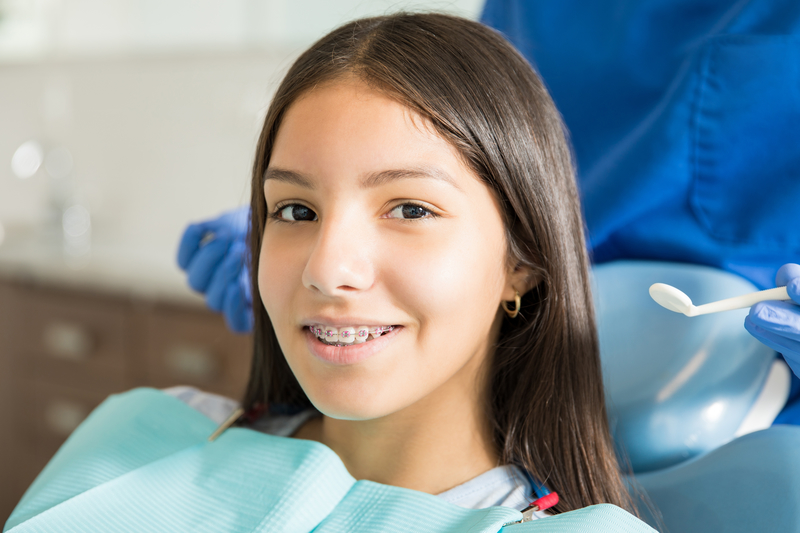
Getting braces through an orthodontist does not mean you should stop seeing a dentist for dental services. In fact, you may even need to get dental services more often with braces. This is because brackets and wires inevitably raise your risk for getting food and plaque stuck in your teeth. Those substances can then lead to quicker tooth decay, gum problems and tooth erosion. Find out what you can expect from your orthodontic visits and why you should keep scheduling in dental services during your treatment.
How Do Braces Change Your Teeth?
Not everyone will get braces during their lifetime. However, for those that do, they can change a smile in incredible ways. You may see children wearing braces from time to time. This is just so they can get a great smile, but that is part of it. Children should see the orthodontist around age 7 or 8 to determine if bite or alignment issues are present. If so, a child could grow up with speech impediments, problems with tooth decay and gum disease, and difficulty chewing, eating and biting. With interceptive orthodontics—or child orthodontics—we can correct those problems so a child develops properly.
With adults and teens, straightening treatment generally starts around age 11 or 12 and older. This is when most (if not all) of the adult teeth have come into the mouth. However, it’s common for the adult teeth to come in crooked, which can make people self-conscious about their smiles. When patients decide to get braces to straighten their teeth, studies show that confidence grows and people show their smiles more. That confidence can lead to more success in the future, motivation to do more and be more, and better oral health.
Straightening the teeth makes the teeth easier to clean. This is because crooked teeth can create areas in the mouth where the teeth are incredibly hard to clean. If you can’t brush nooks and crannies well or if you can’t pass floss through the teeth, those areas are likely to decay. Teeth that are crooked or at different angles also have different amounts of pressure placed on them, which can cause the teeth to crack or break under pressure. That is why straightening the teeth can help prevent not only dental emergencies, but also problems like tooth decay and gum disease.

Changes You Want to Avoid
With your dental health, you always want to invest in dental services like dental cleanings, comprehensive exams and your own at-home cleaning. If not, you can start to develop problems with cavities and gum disease. Both of these conditions (as well as bad breath, oral sores and more) stem from poor oral hygiene. When you eat, bacteria in the mouth mix with sugars in your food to create a sticky film called plaque. That film is acidic and it sticks to your teeth instead of being swallowed. The acid erodes the layers of your teeth, decaying them to create cavities. This is how they form, and they can happen much easier with braces.
Three types of braces you can choose (traditional, lingual, ceramic) will require brackets and wires attached to your teeth. The brackets are bonded to the center of your teeth, with a wire that runs through them. Your brackets are areas where plaque and food can easily get stuck. If they become stuck or particles build up around your brackets, this can create areas of decay rather quickly. Many people also don’t floss like they should with braces because it takes just a bit longer. However, when food sticks around and you skip flossing, you are leaving about 40% of your tooth surfaces open to decay. That means, when you get your braces off, you’ll be left with areas of tooth erosion (or craters) and cavities.
You also want to avoid foods with dyes in them, including drinks. When you drink or eat something with dyes (like blueberries, strawberries, blackberries and drinks died those colors), then your tooth color can change over time. This could mean that you have small squares on all of your teeth at the end of treatment that are a different color than the rest of your teeth. Soda, juices and carbonated drinks can all do this as well, except that they will also wear away parts of your teeth.
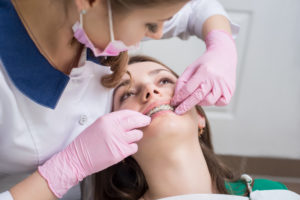
Continue Dental Services During Braces
All of those changes to your teeth can be avoided if you keep up on your personal hygiene at home and dental services in-office. This means, you should:
- Brush your teeth every single day, after every single meal, for two minutes each time you brush. Practice brushing at 45-degree angles to dislodge food from brackets and cover all the tooth surfaces. Use a proxabrush to dislodge stuck food even easier.
- Floss each day, at least 1-2 times. Use a floss threader or threadable floss to make this easy for you.
- Use a waterpik tool if you tend to get food stuck in specific places.
- Keep up on your braces adjustments and your orthodontic appointments.
- For dental services, make sure you visit the dentist at least twice a year for comprehensive exams and dental cleanings.
We want to focus on that last one. Dental cleanings and comprehensive exams are so important for the health of your mouth. With dental cleanings, the hygienists can do thorough cleanings on your teeth and brackets and spot the signs of erosion, decay and color changes. Those professionals can spot the signs of decay and gum issues. If needed, we can work with them to remove certain brackets where dental work is needed. Orthodontists and dentists are not the same even though they have had the same schooling. Make sure you are visiting both during your time with braces. If you want to avoid problems with cleaning brackets and wires, ask us about our Invisalign treatment option. You can do this by calling Belmar Orthodontics at (303) 225-9016!
Be Vigilant with Your Child’s Oral Health
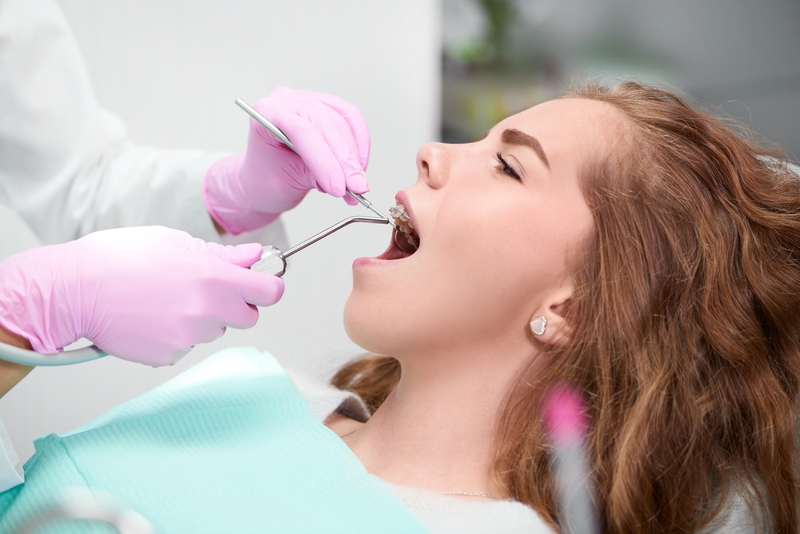
More than half the people that wear braces are children and teens. This can be an exciting time for kids to fix bite problems and crooked teeth. However, tooth decay and oral health problems also run rampant during braces if oral hygiene guidelines aren’t followed. Sometimes children and teens need a nudge to help them with their oral health. Find out what they should be doing to care for their braces during this time!
Facts About Braces
Did you know that there are over 4 million people in the United States each year that wear braces? About 1/4th of those are adults and the rest are children and teens. Patients use braces as teens to straighten the adult, permanent teeth that have come in. When children have child orthodontics, those brackets and wires are meant to correct bite and alignment issues that could cause a child severe problems in the future. Children can then straighten their permanent teeth later on.
There are common oral health problems that many children face today. It’s called tooth decay, and the National Institutes of Health reports that it’s the most “prevalent, chronic disease” among children and adults. 42% of children will have tooth decay before they are 12. 23% of those will have untreated dental decay. About 92% of adults have had tooth decay sometime in their life. The worst part about this is that tooth decay is completely preventable if a child, teen or adult has good oral health through practicing proper oral hygiene.
It may take several years for a child to have the right dexterity in their hands to brush and floss correctly. That is why parents must take care of their child’s oral health when they are young, or it could lead to serious problems. Children rely on parents to help their mouth stay healthy. Even teens need to be told to brush and floss, as it’s something they often forget. These habits are especially important during braces, as oral health is most affected when there are brackets and wires on the teeth.
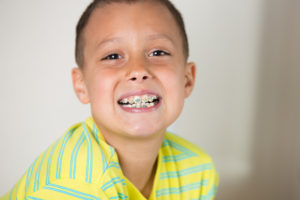
Helping Your Child’s Oral Health
The American Academy of Pediatrics recommends that children see a dentist around 1 year or within 6 months of their first tooth coming in. After that, they should go biannually to the dentist. This is how a dentist can start to see signs of bite and alignment problems, which are then referred to an orthodontist.
With some orthodontic appointments, a child can be fitted for braces to correct problems that are easy to fix with a young, moldable jaw, but hard to fix when a person is older and their jaws are set. Without braces, you will have to help your child brush and floss their teeth at least twice a day as the American Dental Association recommends. Use child toothpaste enhanced with decay-fighting fluoride and a toothbrush that fits the size of your child’s mouth.
Children will need to floss between their teeth, but might have to start out with flossers for kids. With braces, children should be brushing at least twice a day, but after every meal is even better. They should brush at 45-degree angles, making sure to move in all different directions to dislodge food that has been stuck in the braces. Flossing is incredibly important as well, as it gets 40% of tooth surfaces that are missed if flossing is skipped. Help them learn how to use threadable floss. This gets poked through the spaces between their teeth, pulled through, and flossed like you would normally do. Use a Christmas tree brush or a waterpik to help them dislodge stuck food.
Do You Have Good Habits?
One of the best ways to help your child with their oral health is to show them its importance through your own actions. If you don’t brush and floss your teeth, your child or teen may not either. When you’re also not visiting the dentist, odds are that your child isn’t either. If you eat a poor diet full of sugar, then your child will do the same. Children often copy what their parents do.
Make sure you are brushing your teeth at least twice a day, especially when your children can see you. Floss your teeth and teach them how to floss properly as well. When you need to go to the dentist, take your children with you and have them get their comprehensive exams and cleanings. All these oral health measures will ensure their mouths stay clean and healthy for years!
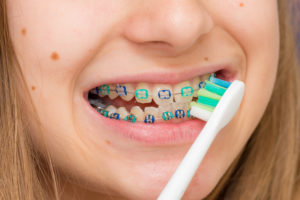
Other Factors to Consider
Your child can brush and floss their teeth often and may still end up with cavities. Cavities come from plaque in the mouth that has set on the teeth for too long. Your mouth makes plaque when you eat sugary foods and that sugar mixes with mouth bacteria to make acidic plaque. That acid is what causes the tooth decay. However, if you limit your sugar intake to begin with, you won’t have the problem with tooth decay.
Unfortunately, sugar is one of the most-consumed substances in the world. It is literally found in almost every food. That is why tooth decay is so common, especially in children. Limit your child’s sugar intake if you want them to have healthy teeth when their braces come off. Teeth that don’t get brushed or flossed often with braces, may end up having cavities, gum disease and eroded areas of their teeth when braces come off.
Their food can also leave them with squares on their teeth from the brackets, because the surrounding tooth has been damaged by food. Make sure to consider what your child is putting in their mouth if you want to help them have good oral health! For more tips or answers to questions about your child’s braces, call Belmar Orthodontics today at (303) 225-9016!
Are Your Teeth Cleaning Habits Good Enough?
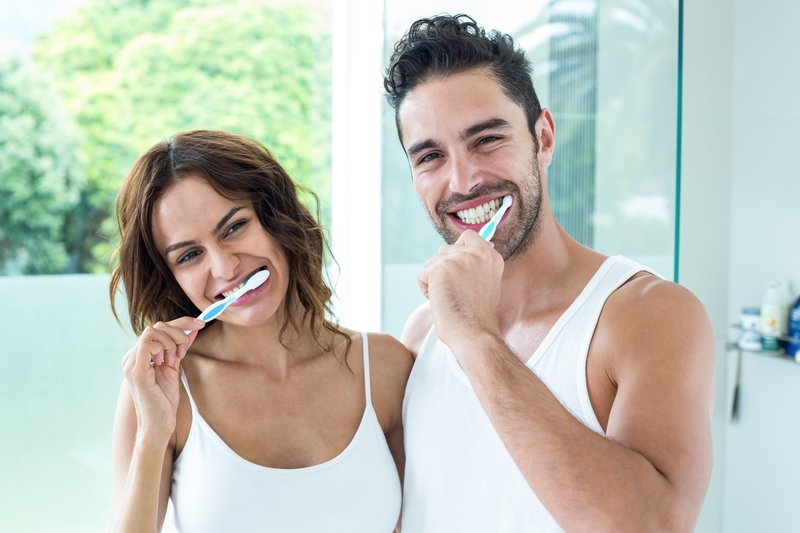
Braces can keep your teeth straighter, making them more beautiful and attractive. However, if your teeth cleaning habits are poor, your smile will take a hit. How well you take care of your teeth before and during braces will be an indication of how your smile will be after your orthodontic care has come to an end. If you don’t brush and floss the teeth enough, you might damage your smile and weaken your enamel. You must step up your cleaning routine during braces to make sure your smile isn’t full of cavities and oral health problems at the end of your care. We can give you the proper recommendations and guidelines to ensure you keep your smile healthy and strong during your time with braces and throughout life.
Brushing With and Without Braces
The American Dental Association recommends brushing and flossing the teeth at least twice a day to keep your mouth healthy and to lower your risk for tooth decay and gum disease. We go beyond that twice-a-day recommendation and suggest that you brush your teeth after every meal. Because your braces can easily attract and trap food particles, brushing after each meal can help prevent staining and reduce the potential for bacteria buildup.
You should use a soft-bristled brush and use one that’s size fits your mouth well. For teeth without braces, the ADA recommends brushing the teeth at a 45 degree angle. Brush each individual tooth, making sure to go all the way up to the gumline. You use a soft-bristled brush to avoid irritating the gums and eroding your tooth enamel. With braces, you want to brush down from the top, then up from the bottom on each tooth with a bracket. This will help dislodge food particles that have become trapped inside the brackets, which is extremely easy to do. Brushing your teeth multiple times a day is one of the best cleaning habits for avoiding decay.
Flossing the Teeth
We recommend flossing your teeth at least once a day. However, that’s for patients that don’t have braces. When you have braces, it’s even more important to floss each and every tooth. It’s also much more time consuming, but the effort you put into your teeth cleaning habits will pay off in the long run. A toothbrush and mouthwash simply can’t get in between the teeth like floss can, so if you skip flossing, you could have food sit and decay your teeth.
You will have to use threadable floss or a floss threader to accomplish this feat with brackets. If you use a floss threader for your teeth, think of your cleaning habits like you’re sewing. You floss the eye of the threader through your teeth and below the archwire. Then you floss the space, pull it out and thread once more. Make sure you don’t apply force or pressure against the archwire as you do this. For some patients, it may take about 10 minutes to floss, but it’s worth taking the time to avoid tooth decay.
Caring for Braces
Caring for your teeth becomes trickier with braces. You will find that you have to devote some extra time to caring for your braces, as you know have about 32 teeth that all have brackets that can collect food. During your time with braces, it is particularly important to maintain good oral health through attention to proper oral hygiene and cleaning habits. If you don’t, you could have your braces removed only to find that many of your teeth have areas of tooth decay. You could also be left with demineralization that leaves marks on all your teeth where the brackets were.
When it comes to caring for your braces, it’s not only important to clear away food particles that are on the teeth, but to be careful of what foods you put into your mouth. To avoid damage to your braces and your teeth during orthodontic treatment, you want to avoid hard foods, sticky foods, and foods high in sugar. This means you should avoid eating foods such as hard candy, chips, ice, apples, nuts, popcorn, carrots, corn on the cob, gum, caramel, taffy, licorice, gummies, and similar foods. Prevention is always key for avoid oral health issues!
Proper Teeth Cleaning Habits
If you’re going to spend 18-24 months straightening your teeth, you might as well keep those teeth healthy so they look nice at the end of your treatment. Brush your teeth every single day, multiple times a day. Floss as well and be meticulous with your cleaning habits. The better care you take of your braces while they’re on, the more you’ll enjoy your smile when they come off. If you would like help with your cleaning habits or tips, call our Belmar Orthodontics office today at (303) 225-9016!

